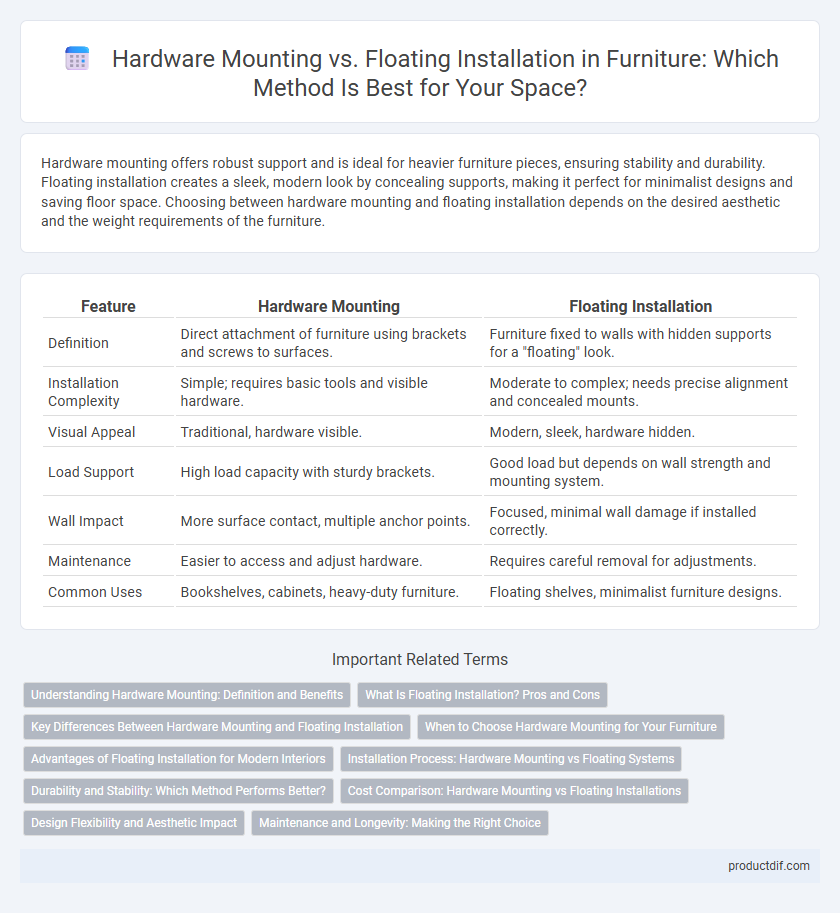Hardware mounting offers robust support and is ideal for heavier furniture pieces, ensuring stability and durability. Floating installation creates a sleek, modern look by concealing supports, making it perfect for minimalist designs and saving floor space. Choosing between hardware mounting and floating installation depends on the desired aesthetic and the weight requirements of the furniture.
Table of Comparison
| Feature | Hardware Mounting | Floating Installation |
|---|---|---|
| Definition | Direct attachment of furniture using brackets and screws to surfaces. | Furniture fixed to walls with hidden supports for a "floating" look. |
| Installation Complexity | Simple; requires basic tools and visible hardware. | Moderate to complex; needs precise alignment and concealed mounts. |
| Visual Appeal | Traditional, hardware visible. | Modern, sleek, hardware hidden. |
| Load Support | High load capacity with sturdy brackets. | Good load but depends on wall strength and mounting system. |
| Wall Impact | More surface contact, multiple anchor points. | Focused, minimal wall damage if installed correctly. |
| Maintenance | Easier to access and adjust hardware. | Requires careful removal for adjustments. |
| Common Uses | Bookshelves, cabinets, heavy-duty furniture. | Floating shelves, minimalist furniture designs. |
Understanding Hardware Mounting: Definition and Benefits
Hardware mounting in furniture involves securely attaching components using brackets, screws, or other physical fasteners, ensuring stability and durability. This method provides enhanced load-bearing capacity and ease of maintenance compared to floating installations. By firmly anchoring furniture, hardware mounting reduces the risk of damage and improves overall structural integrity.
What Is Floating Installation? Pros and Cons
Floating installation refers to a furniture mounting technique where cabinets or shelves are attached directly to the wall without visible supports, creating a sleek, minimalist look and maximizing floor space. Pros include an enhanced modern aesthetic, ease of cleaning under furniture, and better accommodation of uneven floors, while cons involve limited weight capacity, more complex installation requiring strong wall anchors, and potential difficulty in relocating furniture once mounted. This method suits lightweight items and spaces prioritizing a clean, open feel but may not be ideal for heavy or frequently moved pieces.
Key Differences Between Hardware Mounting and Floating Installation
Hardware mounting involves securing furniture directly to walls or floors using brackets, screws, or anchors, providing robust support for heavy or frequently used pieces. Floating installation conceals mounting hardware behind the furniture, creating a sleek, modern look by appearing to levitate off the ground, ideal for minimalist designs and easy floor cleaning. Key differences include visibility of mounting components, weight capacity, and aesthetic impact, with floating installations often requiring precise wall reinforcement for stability.
When to Choose Hardware Mounting for Your Furniture
Hardware mounting is ideal for heavy or frequently used furniture pieces requiring maximum stability, such as wall-mounted shelves or cabinets that bear significant weight. This installation method ensures secure attachment to studs or solid surfaces, preventing sagging and potential damage over time. Choose hardware mounting when durability and safety are priorities, especially in high-traffic areas or homes with children and pets.
Advantages of Floating Installation for Modern Interiors
Floating installation offers a sleek, minimalist aesthetic by concealing hardware and creating the illusion of furniture hovering off the floor, ideal for modern interiors emphasizing clean lines and open space. This method enhances ease of cleaning and maintenance by providing unobstructed access beneath cabinetry or shelving. Furthermore, floating fixtures contribute to a lighter, airier room ambiance while maximizing floor space, making them highly favored in contemporary design schemes.
Installation Process: Hardware Mounting vs Floating Systems
Hardware mounting requires attaching brackets or screws directly to the wall studs, ensuring a sturdy and reliable support for heavy furniture pieces. Floating installation involves concealed brackets or mounting plates fixed to the wall, creating a seamless appearance with no visible supports. The process of hardware mounting is generally more straightforward but may leave visible fasteners, while floating systems demand precise alignment and additional reinforcement to maintain safety and aesthetics.
Durability and Stability: Which Method Performs Better?
Hardware mounting offers superior durability and stability due to the direct attachment of furniture components using screws, brackets, and fasteners, ensuring a strong and long-lasting connection. Floating installation relies on hidden supports, which can provide a sleek appearance but may compromise structural integrity under heavy loads or frequent use. For optimal performance, hardware mounting is the preferred method in high-traffic or weight-bearing furniture applications.
Cost Comparison: Hardware Mounting vs Floating Installations
Hardware mounting typically incurs lower upfront costs due to simpler installation processes and readily available materials, making it a budget-friendly option for furniture assembly. Floating installations often involve higher expenses because of specialized brackets, reinforcements, and professional labor needed to securely anchor furniture to walls. Long-term cost considerations include maintenance and potential repairs, with hardware mounting offering easier adjustments compared to floating installations, which may require more intricate servicing.
Design Flexibility and Aesthetic Impact
Hardware mounting offers robust support and allows for varied design elements such as visible brackets or custom metal fixtures, enhancing the industrial or traditional aesthetic of furniture pieces. Floating installation creates a sleek, minimalist look by concealing mounts within the furniture, optimizing clean lines and making spaces appear larger and more open. Designers leverage floating installation for modern interiors, while hardware mounting suits styles that emphasize structural character and visual interest.
Maintenance and Longevity: Making the Right Choice
Hardware mounting offers robust support and easier access for repairs, enhancing long-term durability and simplified maintenance. Floating installations provide a sleek, modern aesthetic but may require specialized upkeep to prevent wear and ensure structural integrity over time. Selecting the appropriate method depends on balancing maintenance convenience with desired longevity and design goals.
Hardware Mounting vs Floating Installation Infographic

 productdif.com
productdif.com